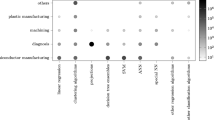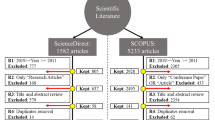Abstract
Flexible job shop scheduling (FJSP) has garnered enormous attention within the realm of smart manufacturing, where, beyond job sequencing, the selection of machines holds considerable importance. As smart factories progress with the Internet of things (IoT) and cyber-physical systems (CPS), scheduling methodologies are advancing towards intelligent decentralization. However, with the expansion of factories, conventional cloud computing struggles to manage the substantial influx of data. To tackle this issue, this work incorporates a fog computing and edge computing framework into the distributed FJSP workstations. In this framework, the workstations each of which consists of multiple machines are categorized based on the different nature of the accommodated machines, and operate independently to reduce unnecessary information transmission, in which each machine is equipped with edge computing capacity. The fusion of fog computing and edge computing allows for the offloading of computational tasks from cloud computing, effectively reducing latency. While previous solutions for FJSP have predominantly relied on linear programming or metaheuristic algorithms, this work proposed a novel distributed approach based on a dual deep Q networks (dual DQN) architecture, integrating deep learning (DL) with reinforcement learning (RL). Within the cloud center, the initial neural network determines the machine selection rules for fog computing, while the secondary neural network decides the job dispatching rules for edge computing devices. Edge computing devices execute the schedule and provide feedback to the cloud, which refines the results through an iterative training process, so that to minimize the makespan. The experimental findings indicate that employing dual DQNs outperforms the methods of utilizing only one single machine selection rule.














Similar content being viewed by others
Data Availability
No datasets were generated or analysed during the current study.
References
Garey MR, Johnson DS, Sethi R (1976) The complexity of flowshop and jobshop scheduling. Math Oper Res 1(2):117–129
Vital-Soto A, Azab A, Baki MF (2020) Mathematical modeling and a hybridized bacterial foraging optimization algorithm for the flexible job-shop scheduling problem with sequencing flexibility. J Manuf Syst 54:74–93
Brucker P, Schlie R (1990) Job-shop scheduling with multipurpose machines. Computing 45:369–375
Sawik T (1990) Modelling and scheduling of a flexible manufacturing system. Eur J Oper Res 45(2–3):177–190
Gran SS, Ismail I, Ajol TA, Ibrahim AFA (2015) Mixed Integer programming model for flexible job-shop scheduling problem (FJSP) to minimize makespan and total machining time. In: Proc. of 2015 International Conference on Computer, Communications, and Control Technology (I4CT). IEEE Press, pp. 413–417
Ho NB, Tay JC (2005) Evolving dispatching rules for solving the flexible job-shop problem. In: Proc. of 2005 IEEE Congress on Evolutionary Computation. IEEE Press, vol. 3, pp. 2848–2855
Rani S, Ahmed SH, Rastogi R (2020) Dynamic clustering approach based on wireless sensor networks genetic algorithm for IoT applications. Wireless Netw 26:2307–2316
Deepalakshmi P, Shankar K (2020) Role and impacts of ant colony optimization in job shop scheduling problems: A detailed analysis. In: Gandomi AH et al (eds) Evolutionary Computation in Scheduling. pp 11–35
Ge HW, Sun L, Liang YC, Qian F (2008) An effective PSO and AIS-based hybrid intelligent algorithm for job-shop scheduling. IEEE Trans Syst Man Cybern Part A Syst Humans 38(2):358–368
Hajibabaei M, Behnamian J (2021) Flexible job-shop scheduling problem with unrelated parallel machines and resources-dependent processing times: a tabu search algorithm. Int J Manag Sci Eng Manag 16(4):242–253
Fan X, Feng X, Dong Y, Hou H (2022) COVID-19 CT image recognition algorithm based on transformer and CNN. Displays 72:102150
Yang MQ, Lin JCW (2022) Digital image feature recognition method of mobile platform based on machine learning. Mobile Netw Appl 27(6):2506–2514
Padmanabhan J, Johnson Premkumar MJ (2015) Machine learning in automatic speech recognition: A survey. IETE Tech Rev 32(4):240–251
Tian H, Zhu Z, Jing X (2023). Deep learning for depression recognition from speech. Mob Netw Appl. in press
Zang J, You P (2023) An industrial IoT-enabled smart healthcare system using big data mining and machine learning. Wireless Netw 29(2):909–918
Marmolejo-Saucedo JA, Kose U (2022) Numerical grad-CAM based explainable convolutional neural network for brain tumor diagnosis. Mob Netw Appl. in press
Williem RS, Setiawan K (2011) Reinforcement learning combined with radial basis function neural network to solve job-shop scheduling problem. In: Proc. of 2011 IEEE International Summer Conference of Asia Pacific Business Innovation and Technology Management. IEEE Press, pp 29–32
Bouazza W, Sallez Y, Beldjilali B (2017) A distributed approach solving partially flexible job-shop scheduling problem with a Q-learning effect. IFAC-Pap Line 50(1):15890–15895
Cisco estimation report. Accessed from: https://www.cisco.com/c/en/us/solutions/collateral/service-provider/global-cloud-index-gci/white-paper-c11-738085.html#_Toc503317525
Lin CC, Tsai CT, Liu YL, Chang TT, Chang YS (2023) Security and privacy in 5G-IIoT smart factories: Novel approaches, trends, and challenges. Mob Netw Appl. in press
Jia G, Han G, Rao H, Shu L (2017) Edge computing-based intelligent manhole cover management system for smart cities. IEEE Internet Things J 5(3):1648–1656
Yi S, Hao Z, Zhang Q, Zhang Q, Shi W, Li Q (2017) Lavea: Latency-aware video analytics on edge computing platform. In: Proc. of the 2nd ACM/IEEE Symposium on Edge Computing. pp 1–13
Shi W, Cao J, Zhang Q, Li Y, Xu L (2016) Edge computing: vision and challenges. IEEE Internet Things J 3(5):637–646
Carlier J (1982) The problem of scheduling with earliest start and due dates: Two-Machine Algorithms. J Oper Res Soc 33(3):275–282
Stecke KE (1983) Formulation and solution of nonlinear integer production planning problems for flexible manufacturing systems. Manage Sci 29(3):273–288
Berrada M, Stecke KE (1986) A branch and bound approach for machine load balancing in flexible manufacturing systems. Manage Sci 32(10):1316–1335
Calleja G, Pastor R (2014) A dispatching algorithm for flexible job-shop scheduling with transfer batches: an industrial application. Prod Plan Control 25(2):93–109
Liangxiao J, Zhongjun D (2015) An improved genetic algorithm for flexible job shop scheduling problem. In: 2015 2nd international conference on information science and control engineering. IEEE Press. pp. 127–131
Rossi A (2014) Flexible job shop scheduling with sequence-dependent setup and transportation times by ant colony with reinforced pheromone relationships. Int J Prod Econ 153:253–267
Riedmiller S, Riedmiller M (1999) A neural reinforcement learning approach to learn local dispatching policies in production scheduling. In: Proc of IJCAI 1999. vol. 2, pp. 764–771
Tawfeek MA, El-Sisi A, Keshk AE, Torkey FA (2013) Cloud task scheduling based on ant colony optimization. In: Proc. of 2013 8th International Conference on Computer Engineering & Systems (ICCES). IEEE Press, pp 64–69
Zhao S, Ding G, Gao Y, Han J (2017) Approximating discrete probability distribution of image emotions by multi-modal features fusion. Transfer 1000(1):4669–4675
Yin L, Luo J, Luo H (2018) Tasks scheduling and resource allocation in fog computing based on containers for smart manufacturing. IEEE Trans Industr Inf 14(10):4712–4721
Park J, Chun J, Kim SH, Kim Y, Park J (2021) Learning to schedule job-shop problems: representation and policy learning using graph neural network and reinforcement learning. Int J Prod Res 59(11):3360–3377
Zhang L (2009) H∞ estimation for discrete-time piecewise homogeneous Markov jump linear systems. Automatica 45(11):2570–2576
Fang Y, Peng C, Lou P, Zhou Z, Hu J, Yan J (2019) Digital-twin-based job shop scheduling toward smart manufacturing. IEEE Trans Industr Inf 15(12):6425–6435
Li R, Gong W, Lu C (2022) Self-adaptive multi-objective evolutionary algorithm for flexible job shop scheduling with fuzzy processing time. Comput Ind Eng 168:108099
Bo LI, Chen GUO, Tao NING (2018) An improved bacterial foraging optimization for multi-objective flexible job-shop scheduling problem. J Eur Syst Autom 51(4–6):323
Wang L et al (2021) Dynamic job-shop scheduling in smart manufacturing using deep reinforcement learning. Comput Netw 190:107969
Mnih V, Kavukcuoglu K, Silver D, Graves A, Antonoglou I, Wierstra D, Riedmiller M (2013) Playing atari with deep reinforcement learning. arXiv preprint arXiv:1312.5602
Sutton RS (1999) Reinforcement learning: past, present and future. In: Proc. of 2nd Asia-Pacific Conference on Simulated Evolution and Learning (SEAL’98). pp 195–197
Hinton GE (2009) Deep belief networks. Scholarpedia 4(5):5947
Watkins CJ, Dayan P (1992) Q-learning. Mach Learn 8:279–292
Zhang Y, Brown D (2014) Simulation optimization of police patrol districting plans using response surfaces. Simulation 90(6):687–705
Nouri HE, Belkahla Driss O, Ghédira K (2018) Solving the flexible job shop problem by hybrid metaheuristics-based multiagent model. J Indust Eng Int 14:1–14
Lin CC, Deng DJ, Chih YL, Chiu HT (2019) Smart manufacturing scheduling with edge computing using multiclass deep Q network. IEEE Trans Industr Inf 15(7):4276–4284
Li X, Gao L (2016) An effective hybrid genetic algorithm and tabu search for flexible job shop scheduling problem. Int J Prod Econ 174:93–110
Borreguero-Sanchidrián T, Pulido R, García-Sánchez Á, Ortega-Mier M (2017) Flexible job shop scheduling with operators in aeronautical manufacturing: A case study. IEEE Access 6:224–233
Funding
This work was sponsored by National Science and Technology Council, Taiwan under Grants NSTC 112-2221-E-A49-116-MY3 and NSTC 112-2221-E-240-001.
Author information
Authors and Affiliations
Contributions
Chun-Cheng Lin and Hui-Hsin Chin conceived of the presented idea, developed the theory, and verified the analytical methods. Yi-Chun Peng, Zhen-Yin Annie Chen, and Yu-Hong Fan contributed to the design and implementation of the research, and to the writing of the manuscript. All authors discussed the results and contributed to the final manuscript. All authors reviewed the manuscript.
Corresponding author
Ethics declarations
Ethics Approval
Not applicable.
Consent to Participate
Not applicable.
Consent for Publication
Not applicable.
Competing Interests
The authors declare no competing interests.
Additional information
Publisher's Note
Springer Nature remains neutral with regard to jurisdictional claims in published maps and institutional affiliations.
Rights and permissions
Springer Nature or its licensor (e.g. a society or other partner) holds exclusive rights to this article under a publishing agreement with the author(s) or other rightsholder(s); author self-archiving of the accepted manuscript version of this article is solely governed by the terms of such publishing agreement and applicable law.
About this article
Cite this article
Lin, CC., Peng, YC., Chen, ZY.A. et al. Distributed Flexible Job Shop Scheduling through Deploying Fog and Edge Computing in Smart Factories Using Dual Deep Q Networks. Mobile Netw Appl (2024). https://doi.org/10.1007/s11036-024-02302-2
Accepted:
Published:
DOI: https://doi.org/10.1007/s11036-024-02302-2




